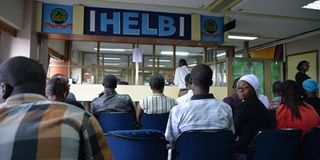Pain for comrades: 140,000 students miss loans as Helb runs out of cash

The Higher Education Loans Board offices in Nairobi.It is unfortunate that the government had to come up with such a decision to leave out some university students from its study loan programme at a time when Kenyans are struggling to survive due to the high cost of living.
Some 140,000 students in public universities and technical and vocational education and training (TVET) colleges have missed State loans after the Higher Education Loans Board (Helb) ran out of cash, setting them up for challenges raising alternative funds for tuition, accommodation and upkeep.
Helb told Parliament on Wednesday that the students will have to wait till the Treasury releases Sh5.7 billion for onward disbursement to them.
The majority of loan applicants come from poor households and require financial support from Helb to pay for their tuition and upkeep.
“Currently we have 140,000 students in Tvets and universities that we have not been able to fund to the tune of Sh5.7 billion because we have run out of the budget that we had presented to Treasury of Sh4.5 billion,” said Helb chief executive Charles Ringera.
The 140,000 students are almost double the 75,000 that the agency could not fund during a similar period last year when the Treasury delayed disbursements of Sh3 billion.
The delayed disbursement means that the students, most of who are first-years will have to find alternative means of paying for their tuition, accommodation and upkeep as they await government funding.
Mr Ringera noted a request to plug the current financing deficit through a supplementary budget was declined.
In the current financial year, the agency was allocated Sh14.8 billion to finance students based on their economic backgrounds.
A successful loan applicant receives between Sh35,000 and Sh60,000 per year.
Of the total loan disbursed, Sh8,000 is sent directly to the university as tuition fees and the balance to the beneficiary’s bank account in two equal tranches covering the first and second semesters.
Helb is supposed to be a revolving fund in which beneficiaries who have completed studies pay back to support a fresh group of students.
This has, however, not been the case in an economic setting that is plagued by a hiring freeze on the back of sluggish corporate earnings.
“Every month we collect around Sh400 million from former loanees which we add to the quarterly disbursements by Treasury to service applications by ongoing students,” he told the National Assembly Public Investments Committee on Education and Governance (PICEG).
The first Treasury disbursement is normally expected around August each year, which is a month before universities and colleges open around September.
“The quarter exchequer release is about Sh3 billion while what Helb has collected by that time is Sh1.2 billion, totalling to around Sh4.2 billion, which is way below the Sh7 billion required to adequately service loan applications,” he said.
To address the mismatch, Helb and the Treasury signed a deal where disbursements will be made every six months rather than every four months.
“So in September last year, Treasury released to us Sh5.6 billion and at the time we had collected about Sh4 billion. When we added the two we were able to settle the entire bill for September/ October,” said Mr Ringera.
When it came to December for semester two, the Treasury released only Sh2.5 billion, with the balance landing on Helb’s account a few weeks ago after learners protested on the streets.
Helb has over the years struggled to meet the rising demand for loans.
The number of government-sponsored students in public universities has grown at the fastest rate in five years.
The number of candidates who made the minimum university entry grade in the 2022 Kenya Certificate of Secondary Education (KCSE) examination rose by 19 percent to 173,345 compared to 145,776 recorded the previous year.
Over the past five years, nearly all students who scored C+ and above were admitted to the regular university programmes, meaning they qualify for Helb loans.
Loan defaulters have weakened Helb’s ability to support the university and technical college students, prompting allocation cuts and increased reliance on the Treasury.
More than 100,000 former university students defaulted on their Helb loans at the peak of the Covid-19 pandemic.





